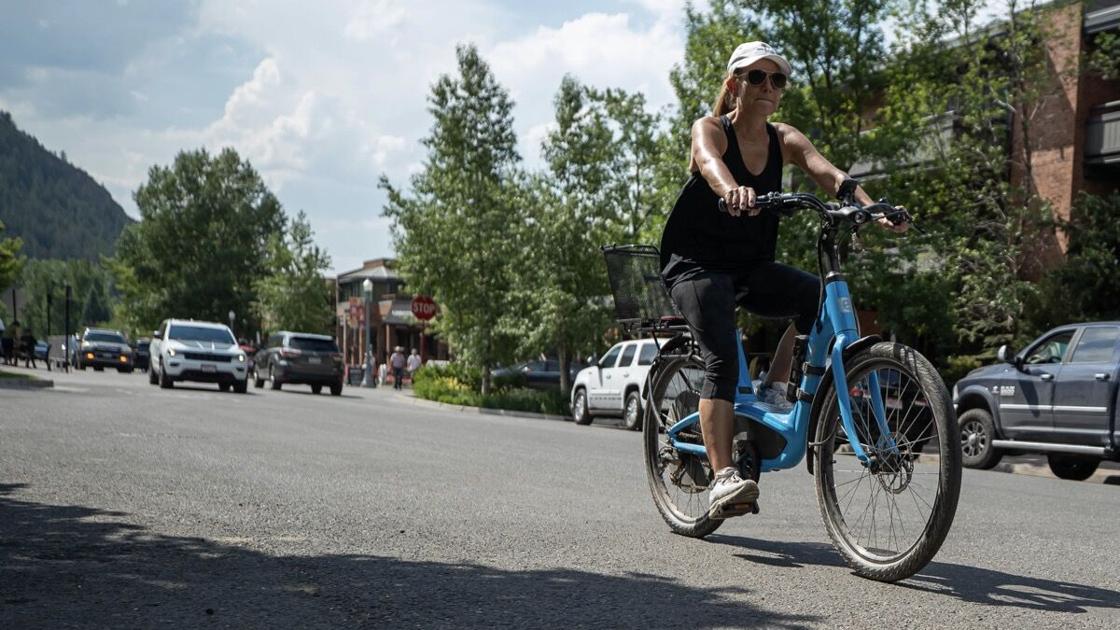
It’s mid-morning on a Tuesday and a group of more than a dozen visitors gets prepped on renting e-bikes for the day. They learn about braking and power levels. An employee shouts out to see if anyone wants helmets, they all say no, and in pods of three and four, the people get on their bikes and set off — immediately blocking traffic and stopping a bus.
“Single file!” shouts the staffer.
This is a semi-standard morning at a bike shop in downtown Aspen. And specifically, it’s more typical when it involves large groups that are renting e-bikes, a market that has dramatically increased in just three years. Local organizations don’t have specific numbers on the surge regionally, but market researchers at the NPD Group found a 140% increase nationally for e-bike sales during the first nine months of 2020, and that doesn’t include direct-to-consumer providers like Rad Bikes or rental statistics.
There’s a consensus that e-bikes are a good thing, but how to manage their numbers and safety is something that agencies, retailers and the hospital are navigating.
“Across the nation, travel management plans didn’t know about e-bikes,” said Scott Fitzwilliams, supervisor for the White River National Forest. “We’re in a situation where technology has passed us up, and we’re struggling across the country on how we should handle this.”
On Forest Service land, e-bikes are restricted to where motorized use is allowed, he said. But officials are continuing to evaluate this because, as Fitzwilliams explained, “e-bikes are here to stay.”
While e-bike use on dirt single-track trails, where they are banned, doesn’t seem to be a major problem in the upper Roaring Fork Valley, according to Pitkin County Open Space and Trails Director Gary Tennenbaum, it’s the rules of the road with which people are struggling.
“You can’t ride three abreast,” said Tennenbaum. “You might think because you’re in Aspen, that’s OK, but it’s still a road. That is the biggest issue that we’ve had.”
This is a continuing problem on Castle Creek and Maroon Creek roads, where access to locations such as the Bells is now available with an electric assist to people who may not otherwise have been able to ride there.
As a refresher, Class 1 e-bikes provide assistance with pedaling, up to a top speed of 20 mph. Class 2 models power the bike ride even when not pedaling, but click off at 20 mph. And Class 3 e-bikes assist pedaling up to a top speed of 28 miles per hour.
“We have a lot of people coming to buy and rent bikes that haven’t ridden bikes in a long time,” said Tim Emling, owner of HUB Aspen. “Just getting that many people out that haven’t ridden bikes in years, if you don’t fundamentally know how to ride a bike, it’s dangerous.”
Emling has partnered with Aspen Valley Hospital to create a series of public service announcements about bike safety and traffic regulations.
“We want people to understand when they’re riding an electric bike, they’re a car,” he said.
AVH is leading the campaign because of the increase in injuries, and the potential for more.
“We are definitely seeing more e-bike injuries,” said Dr. Chris Roseberry, trauma medical director for AVH. “It’s hard to know if those injuries are coming from simply more people on e-bikes or because more people are actually getting injured. But, one of the common denominators in the injury pattern is they don’t realize how heavy the bikes are and don’t stop them in time. … Also they go so fast, so quickly, that they lose control of their bike.”
His department sees about 300 bike-related injuries annually, and the percentage of those coming from e-bikes has risen from 10% in 2019 to 35% to date this year.
“We’re all predicting those numbers to be much higher, with the hotels fully booked and everyone getting out after COVID, e-bikes have exponentially increased,” he said.
The most common types of injuries are broken wrists and rib fractures, which can result in respiratory issues from punctured lungs. Most frequently, the accidents are happening to people 60 and over, he said. And though head injury rates have remained low, he’d like to see more people wearing helmets in general, whether they’re on e-bikes or regular bikes.
“Helmets will turn a moderate injury into a mild one, and a severe injury into a moderate one,” he said.
Proactively, the Forest Service, Pitkin County Open Space and Trails and retailers are working together on an education campaign.
“We’re hoping rental shops can get through to people,” Tennenbaum said. “It’s in everyone’s best interest to see if this works.”
Ed Garland, owner of Aspen Bike Rentals — Aspen’s largest rental fleet — agreed.
“If you rent a car to someone, you can’t make people not speed,” he said. “We provide a service and we can strongly recommend to people to do things like wear helmets and ride single file, and we can let people know they need to obey the rules of the road.”
His rental inventory sold out many days in 2020, and he expects this summer to be the same.
“It’s super popular, and now we need to figure out how to make it work for everyone.”
"use" - Google News
June 18, 2021 at 04:00PM
https://ift.tt/35yEA5d
As e-bike use increases, organizations adjust - Aspen Daily News
"use" - Google News
https://ift.tt/2P05tHQ
https://ift.tt/2YCP29R
Bagikan Berita Ini














0 Response to "As e-bike use increases, organizations adjust - Aspen Daily News"
Post a Comment